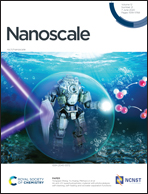Pollen-derived porous carbon decorated with cobalt/iron sulfide hybrids as cathode catalysts for flexible all-solid-state rechargeable Zn–air batteries†
Abstract
The development of flexible all-solid-state rechargeable Zn–air batteries (FS-ZABs) for wearable applications faces challenges from the balance between performance and flexibility of the battery; efficient cathode catalyst and reasonable electrode construction design are key factors. Herein, a low-cost pollen derived N,S co-doped porous carbon decorated with Co9S8/Fe3S4 nanoparticle hybrids (Co–Fe–S@NSRPC) has been synthesized. Owing to the active Co9S8/Fe3S4 nanoparticles, N,S co-doping, and large specific area of the pollen derived porous carbon matrix, the Co–Fe–S@NSRPC composite exhibits an excellent bifunctional catalytic activity with a small potential gap (ΔE = 0.80 V) between the half-wave potential for the ORR (0.80 V) and the potential at 10 mA cm−2 for the OER (1.60 V), and endows a liquid Zn–air battery with a high power density of 138 mW cm−2, a larger specific capacity of 891 mA h g−1 and a stable rechargeability of up to 331 cycles. Based on the Co–Fe–S@NSRPC cathode catalyst, a 2D coplanar FS-ZAB has been fabricated with specially designed parallel narrow strip electrodes alternately arrayed on a polyacrylamide polyacrylic acid copolymer hydrogel solid electrolyte. The presented FS-ZAB exhibits excellent battery performance with high open-circuit-voltage (1.415 V), competitive peak power density (78 mW cm−2), large specific capacity (785 mA h g−1) and stable rechargeability (150 cycles), offers robust flexibility to maintain stable charge/discharge capacity under different bending deformations, and provides convenient coplanar integrability to realize parallel or series connection of multiple cells in a relatively small area.



 Please wait while we load your content...
Please wait while we load your content...